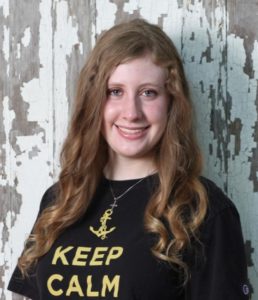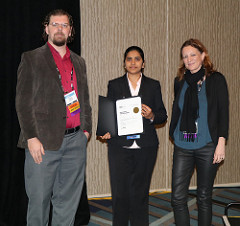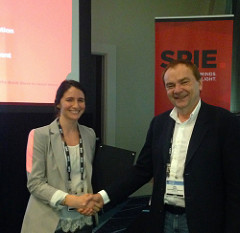VISE affiliates honored at the February 2018 SPIE Medical Imaging Conference
Four VISE affiliates were recognized for their outstanding work this year at the annual SPIE Medical Imaging meeting.
 Meg Bobo, a sophomore in electrical engineering, won the Cum Laude Poster Award in the Image Processing conference for her poster, “Fully convolutational neural networks improve abdominal organ segmentation.”
Meg Bobo, a sophomore in electrical engineering, won the Cum Laude Poster Award in the Image Processing conference for her poster, “Fully convolutational neural networks improve abdominal organ segmentation.”
Posters are reviewed by conference committees and chosen for exceptional quality.
Her work is breaking new ground.
“No one has ever used fully convolutional neural networks to segment abdominal organs in MRI’s before, so I feel that I am really contributing to the field,” she said. “Beyond that, my research showed promising results, so it has the potential to be used someday.”
“I am also extremely grateful to my co-authors for all of their work,” said Bobo, who participated in the VISE Summer Undergraduate program in the Medical-image Analysis and Statistical Interpretation (MASI) Lab in 2017.
 Yiyuan Zhao, a graduate student in electrical engineering, was one of two runners up for the Seimens Young Scientist Award with his paper, “Validation of cochlear implant electrode localization techniques.” The award goes to the best papers in the SPIE Medical Imaging in the Image-Guided Procedures, Robotic Interventions, and Modeling conference each year with an early career scientist as the primary author, based on nomination by their advisor.
Yiyuan Zhao, a graduate student in electrical engineering, was one of two runners up for the Seimens Young Scientist Award with his paper, “Validation of cochlear implant electrode localization techniques.” The award goes to the best papers in the SPIE Medical Imaging in the Image-Guided Procedures, Robotic Interventions, and Modeling conference each year with an early career scientist as the primary author, based on nomination by their advisor.
“I appreciate my advisers recommending me for this Young Scientist competition and gave me constructive feedbacks for my research all the time,” said Zhao, a member of the Medical Image Processing (MIP) lab.
“I see this award as an honor and also a motivation for working harder,” he said.
Additionally, VISE has two finalists for The Robert F. Wagner All-Conference Best Student Paper Award. The chairs of each subconference submit a single paper with a student as first author.
 Prasanna Parvathaneni, graduate student in electrical engineering and member of the Medical-image Analysis and Statistical Interpretation (MASI) Lab, was a finalist in the Imaging Processing conference with her paper titled, “Constructing statistically unbiased cortical surface templates using feature-space covariance.”
Prasanna Parvathaneni, graduate student in electrical engineering and member of the Medical-image Analysis and Statistical Interpretation (MASI) Lab, was a finalist in the Imaging Processing conference with her paper titled, “Constructing statistically unbiased cortical surface templates using feature-space covariance.”
“I feel so humbled to know that our paper got nominated and I am proud to be part of MASI Lab that made it possible,” Parvathaneni said. “I hope this work eventually finds application in practical solutions for clinical and research studies.”
 The paper of Jaime Tierney, a Biomedical Elasticity and Acoustical Measurement (BEAM) Lab member, was the pick from the Ultrasound Imaging and Tomography conference Her paper was titled, “Combining adaptive demodulation with singular value decomposition filtering for improved non-contrast perfusion ultrasound imaging.”
The paper of Jaime Tierney, a Biomedical Elasticity and Acoustical Measurement (BEAM) Lab member, was the pick from the Ultrasound Imaging and Tomography conference Her paper was titled, “Combining adaptive demodulation with singular value decomposition filtering for improved non-contrast perfusion ultrasound imaging.”
Accurate non-contrast perfusion ultrasound imaging could help doctors make faster, more informative diagnoses while also sparing patients radiation exposure and costing less, said Tierney, graduate student in biomedical engineering.
“My research excites me because it has the potential to make a tangible difference in patient care,” she said.

